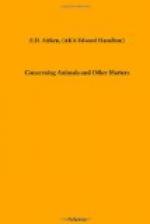How plainly a new avenue from the outer world into its mind has been opened by those fingers! But how about scratching? What would be the gain of having higher susceptibilities and keener perceptions if they only aggravated the triumph of the insulting flea? Nay, this disaster has been averted by reserving a good sharp claw on the forefinger (not the thumb) of each hind hand.
The old naturalists called the apes and lemurs Quadrumana, the “four-handed,” and separated the Bimana, with one species—namely, Homo sapiens. Now we have anatomy cited to belittle the difference between a hand and a foot, and geology importuned to show us the missing link, pending which an order has been instituted roomy enough to hold monkeys, gorillas, and men. It is a strange perversity. How much more fitting it were to bow in reverent ignorance before the perfect hand, taken up from the ground, no more to dull its percipient surfaces on earth and stones and bark, but to minister to its lord’s expanding mind and obey his creative will, while his frame stands upright and firm upon a single pair of true feet, with their toes all in one rank.
II
BILLS OF BIRDS
The prospectus, or advertisement, of a certain American typewriting machine commences by informing the public that “The —— typewriter is founded on an idea.” When I saw this phrase I secured it for my collection, for I felt that, without jest, it contained the kernel of a true philosophy of Nature. The forms, the phainomena, of Nature are innumerable, multifarious, interwoven, and infinitely perplexing, and you may spend a happy life in unravelling their relations and devising their evolutions; but until you have looked through them and seen the ideas that are behind them you are a mere materialist and a blind worker. The soul of Nature is hid from you.
What is the bill of a bird and what does it mean? I do not refer to the bill of a hawk, or a heron, or an owl, or an ostrich, but to that which is the abstract of all these and a thousand more. I hold, regardless of anatomy and physiology, that a bird is a higher being than a beast. No beast soars and sings to its sweetheart; no beast remains in lifelong partnership with the wife of its youth; no beast builds itself a summer-house and decks it with feathers and bright shells. A beast is a grovelling denizen of the earth; a bird is a free citizen of the air. And who can say that there is not a connection between this difference and other developments? The beast, thinking only of its appetites, has evolved a delicate nose, a discriminating palate, three kinds of teeth to cut, tear, and grind its food, salivary glands to moisten the same, and a perfected apparatus of digestion.
[Illustration: GOOD FOR ANY ROUGH JOB]




